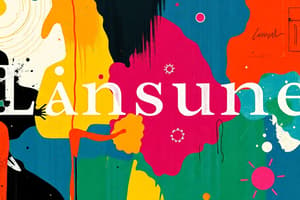Podcast
Questions and Answers
What is a simile?
What is a simile?
- Comparison between 2 things using like or as. (correct)
- Comparison between 2 things using like or as.
- Comparison between 2, unlike things without like or as.
- An exaggeration
What is a metaphor?
What is a metaphor?
- Comparison between 2, unlike things without like or as.
- Comparison between 2, unlike things but without using 'like' or 'as'. (correct)
- An exaggeration
- Comparison between 2 things using like or as.
What is a hyperbole?
What is a hyperbole?
- An exaggeration (correct)
- Comparison between 2 things using like or as.
- Giving human characteristics to an inanimate object.
- Comparison between 2, unlike things without like or as.
What is personification?
What is personification?
What is an analogy?
What is an analogy?
What is an oxymoron?
What is an oxymoron?
What is an allusion?
What is an allusion?
What is an understatement?
What is an understatement?
What is metonymy?
What is metonymy?
What is synecdoche?
What is synecdoche?
What is symbolism?
What is symbolism?
What is an euphemism?
What is an euphemism?
What is alliteration?
What is alliteration?
What is consonance?
What is consonance?
What is rhyme?
What is rhyme?
What is slant rhyme?
What is slant rhyme?
What is internal rhyme?
What is internal rhyme?
What is onomatopoeia?
What is onomatopoeia?
What is euphony?
What is euphony?
What is flashback?
What is flashback?
What is foreshadowing?
What is foreshadowing?
What is point of view?
What is point of view?
Flashcards
Simile
Simile
Comparing two things using "like" or "as".
Metaphor
Metaphor
Comparing two unlike things without using "like" or "as".
Hyperbole
Hyperbole
Exaggeration for effect.
Personification
Personification
Signup and view all the flashcards
Analogy
Analogy
Signup and view all the flashcards
Oxymoron
Oxymoron
Signup and view all the flashcards
Allusion
Allusion
Signup and view all the flashcards
Understatement
Understatement
Signup and view all the flashcards
Idiom
Idiom
Signup and view all the flashcards
Metonymy
Metonymy
Signup and view all the flashcards
Synecdoche
Synecdoche
Signup and view all the flashcards
Symbolism
Symbolism
Signup and view all the flashcards
Allegory
Allegory
Signup and view all the flashcards
Alliteration
Alliteration
Signup and view all the flashcards
Consonance
Consonance
Signup and view all the flashcards
Assonance
Assonance
Signup and view all the flashcards
Rhyme
Rhyme
Signup and view all the flashcards
Slant Rhyme
Slant Rhyme
Signup and view all the flashcards
End Rhyme
End Rhyme
Signup and view all the flashcards
Internal Rhyme
Internal Rhyme
Signup and view all the flashcards
Study Notes
Rhetorical/Literary Devices
- Simile: Comparison between two things using "like" or "as".
- Metaphor: Comparison between two unlike things without "like" or "as".
- Hyperbole: Exaggeration
- Personification: Giving human characteristics to an inanimate object.
- Analogy: Comparison between two unlike things.
- Oxymoron: Pairing of two words with opposite meanings (e.g., hot/cold).
- Allusion: Reference to something outside the text.
- Understatement: Ironically making a situation seem less important than it is.
- Idiom: Widely used expressions that don't match their literal meaning (e.g., "it's raining cats and dogs").
- Metonymy: Replacing an object with something related to it instead of stating the object directly (e.g., using "pen" to mean writing).
- Synecdoche: Using a part to represent a whole.
- Symbolism: The multiple meanings or representations of something.
- Allegory: When multiple aspects of a work represent or symbolize larger ideas.
- Euphemism: Replacing an unpleasant word with a more pleasant one (e.g., "passed away" instead of "died").
Sound Devices
- Alliteration: Repetition of initial consonant sounds (e.g., "Peter Piper picked").
- Consonance: Repetition of consonant sounds in a sequence of words.
- Assonance: Repetition of vowel sounds.
- Rhyme: Words that sound the same.
- Slant Rhyme: Words that share similar but not identical sounds.
- End Rhyme: Rhymes at the end of lines.
- Internal Rhyme: Rhymes within a line.
- Onomatopoeia: Words that imitate sounds (e.g., "boom," "clack").
- Euphony: Pleasing combinations of words.
- Cacophony: Harsh or unharmonious sounds.
Structure
- Flashback: Telling events from the past.
- Foreshadowing: Giving clues about future events.
- Point of View: The perspective from which a story is told (e.g., first person, "I").
Studying That Suits You
Use AI to generate personalized quizzes and flashcards to suit your learning preferences.



